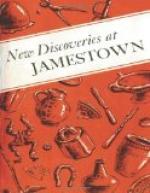As there is no record of spinets, or virginals, having been used at Jamestown, we have no way of knowing whether such wire-stringed, keyboard instruments were used in the homes of the more prosperous planters, together with other musical instruments of the period.
It is quite certain, however, that the Jamestown settlers knew the songs and ballads which were sung in Great Britain in those days. They were also familiar with English, Irish, Welsh, and Scotch dances. A few contemporary accounts reveal that the Virginia colonists enjoyed merry tunes and ditties, as well as lively dances. Although living in a wilderness, there were times when they could enjoy a few leisure-hour activities and amusements, including singing and dancing.
[Illustration: Playing A Jew’s Harp—enjoying A little Music in the Virginia wilderness. (Conjectural sketch by Sidney E. King.)]
[Illustration: An assortment of Jew’s harps unearthed at Jamestown.]
[Illustration: A few objects recovered at Jamestown which were once used on 17th-century boats—reminders of A day when travel in Virginia was largely by water.]
Travel
During the 17th century, travel in Virginia was mainly by boat. As the roads leading from Jamestown to the nearby settlements were usually in deplorable condition, especially after heavy rains, the settlers preferred to travel by water whenever possible. As the colony grew, and roads were improved somewhat, travel by horse became more common, especially for short trips. After 1650 the use of wagons increased, and records indicate that a few of the more prosperous planters imported fine carriages from England.
BOATS AND SHIPS
Boats used by the settlers varied in size from small flat-bottom boats to fairly large sailing vessels, and included such types as small rowboats, pinnaces, barks, bilanders, schooners, ketches, and sloops. Living on a river, and in a tidewater area of innumerable creeks, bays, and rivers, practically all of the colonists were familiar with handling boats of one type or another.
However, only a few objects relating to boats and ships have been unearthed at Jamestown: small anchors, chains, oar locks, ship bolts and spikes, and tools used by shipwrights and ships’ carpenters.
[Illustration: Some bits and bridle ornaments in the Jamestown collection. The artistic designs on many bridle bosses are symbolic of beautiful handiwork performed by craftsmen of A bygone day.]




